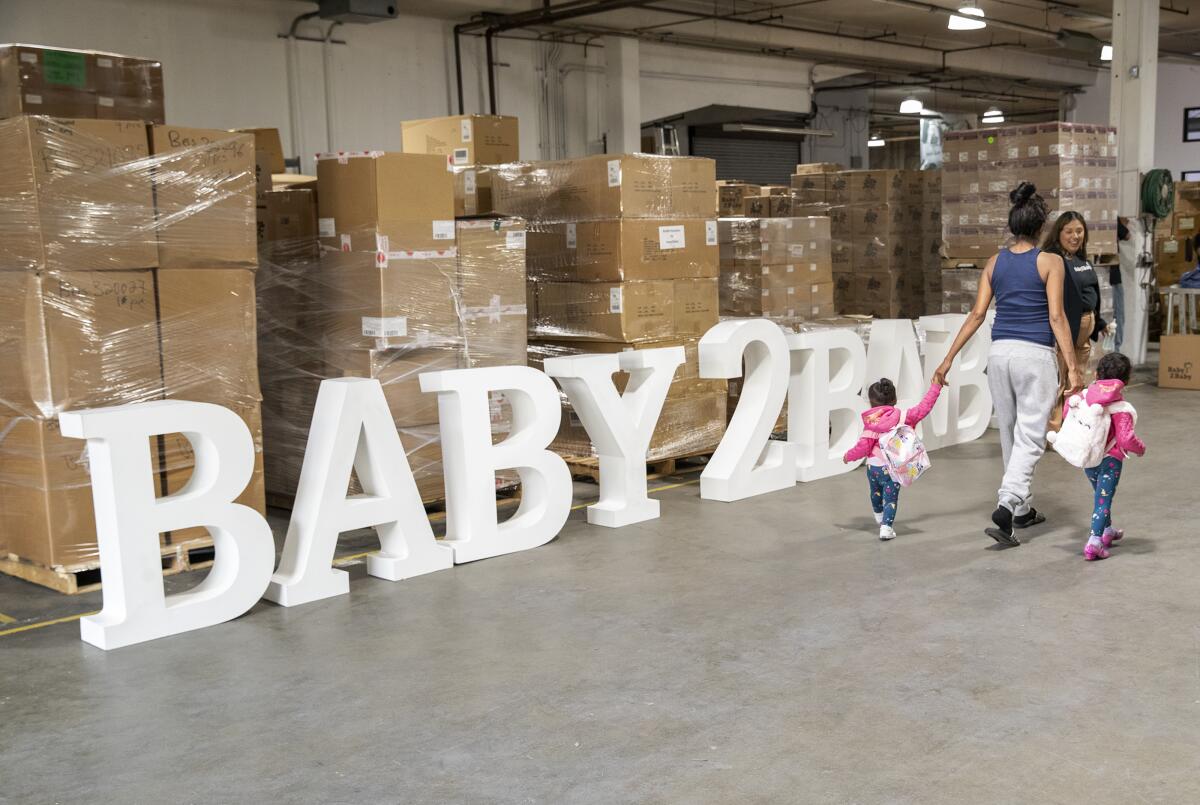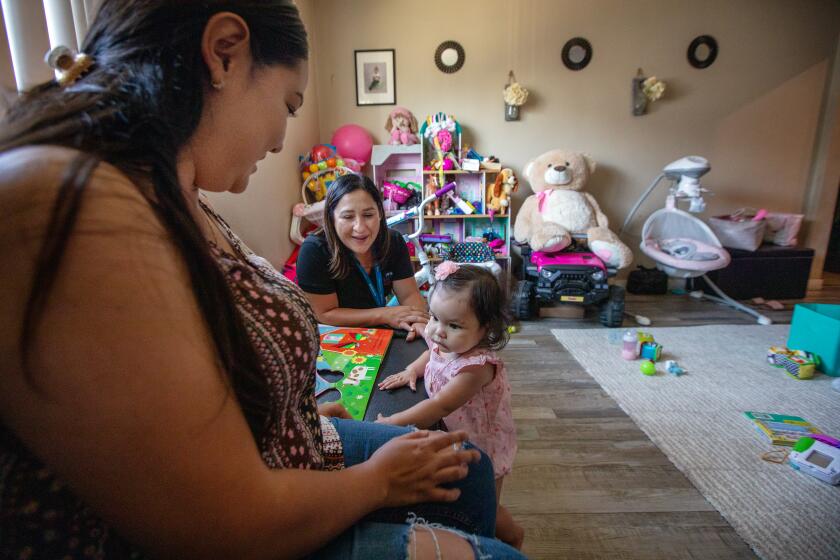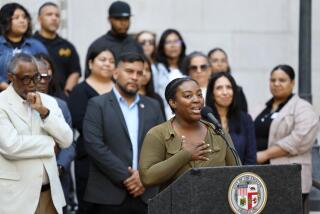An ‘invisible’ need: Diapers top the holiday wish list for many L.A. parents

- Share via
Maria’s holiday list was more about essentials than wishes. Coats for her children as the weather turns cold. Blankets to keep them warm. A few presents to put under the Christmas tree. And a box of diapers.
“I just want my kids to be happy,” said Maria, a single mother of three boys, who asked that only her first name be published.
But providing for her baby has been challenging. She hasn’t been able to afford enough diapers. So she improvised, and learned to stretch her limited supply. She kept them on even when they filled up or left his bottom bare at home. Sometimes she wrapped him in cotton cleaning cloths to keep him dry, washing them by hand.
But earlier this year, Maria found out about a program through his older brother’s Los Angeles Unified School District campus that helped her. She found a way to receive free diapers, formula and other essential items directly from the school, goods provided by an L.A. nonprofit called Baby2Baby. She received coats, shoes, blankets and for Christmas, bags of presents, wrapped and ready.
“I don’t have to worry about diapers anymore or the formula or them being hungry or being cold or not having clothes or blankets,” Maria said. “Baby2Baby has made my life so much lighter than it was before.”
California’s tobacco tax funds resources for young kids. But with sales declining and a flavored tobacco ban in place, First 5’s child programs are at risk.
Diapers are a basic need for families with young children like Maria’s, on par with shelter, food and heat. Yet even as diaper prices have soared 22% since 2018, most existing government aid programs — including WIC — do not cover them. And while low-income parents can use their monthly government assistance to pay for diapers, the $75 average monthly cost to diaper an infant can take an outsize portion of their benefit, sometimes up to 40%. Because low-income families tend to purchase diapers in smaller, more expensive quantities rather than in bulk, they often end up paying far more.
Half of families in the United States report they cannot afford enough diapers to keep their children clean and dry — up from 1 in 3 in 2017, according to recent data from the National Diaper Bank Network. One in 4 families reported missing work or school in the past year because they did not have enough diapers to drop their child off at a childcare program, most of which require a daily supply provided by parents.
California has been a national leader in helping to make diapers more affordable for families, said Jennifer Randles, a professor of sociology at Fresno State University who studies diaper need. In 2018, many welfare recipients in the state became eligible for an additional $30 monthly voucher for diapers. And in 2020, California joined a wave of states in rescinding the sales taxes on diapers.
Still, the need persists for many California families, and diaper banks like Baby2Baby provide a lifeline, as well as a symbolic importance.
“The very existence of food banks sends the message that food is a basic need we should all have access to,” said Randles. “Diaper banks send the message that diapers are an essential need that we should all have access to. For a lot of people its very invisible.”
Baby2Baby, headquartered in Culver City, is one of the country’s largest nonprofit distributors of diapers and other essential items for families. This year alone, the organization has distributed 40 million diapers across the country, all of which passed through one of its three L.A. warehouses.
Every day, trucks bearing diapers, wipes, clothing, car seats and toys fan out across L.A., stocking the shelves of more than 500 partner organizations, including shelters, clinics, food pantries, and every school district in the county. For some trucks, it’s the beginning of a much longer journey, to partners who serve needy families in all 50 states.
Baby2Baby launched 12 years ago in its current form, the brainchild of two women — one a model and one a corporate lawyer — who wanted to fill an essential need in the community. They started asking local social-service nonprofits what they needed most.
“They all came back to us with the same thing. They said that they needed diapers,” said co-CEO Norah Weinstein, the former lawyer. “It was not what we were expecting.”
Diapers were crucial to every other service the groups wanted to provide, the nonprofits told her. “They couldn’t get mothers to come to wellness visits, they couldn’t get mothers to have their children attend school, they couldn’t get them to come parenting classes. They couldn’t do any of it when their child was screaming in a dirty diaper.”
Twelve years later, the organization has distributed 375 million items to children in homeless shelters, domestic violence programs, foster care, hospitals and underserved schools across the country, including 170 million diapers. Last year, the organization raised $70 million in cash and in-kind donations.
When requests increased by 500% during the pandemic, Baby2Baby started manufacturing its own diapers, which Weinstein said saved 80% over the retail cost and increased distribution fivefold. Still, Weinstein said, they are careful not to congratulate themselves.
“We feel like we’re just scratching the surface,” she said. This year alone, Baby2Baby received requests for 1.3 billion diapers.
For the more than 500 L.A. organizations that distribute Baby2Baby items, the service is often a crucial part of their service.
California’s 4-year-olds are entering transitional kindergarten. But many young learners aren’t fully potty-trained, an issue public schools are grappling with.
L.A. Unified, for example, has given out 15 million items donated by Baby2Baby over the past 11 years, including diapers for the young siblings of students.
“This reflects on one hand a beautiful demonstration of kindness and strategic contribution,” said Supt. Alberto M. Carvalho. “On the other hand, it is a reflection of the challenge and poverty levels that many of our kids and families face.”
Jimmy Douglas, director of community engagement at LA Family Housing, a nonprofit serving 13,000 people that helps find housing and other services, said that about half of the items it distributes were provided by Baby2Baby.
Each month, Douglas said , he sends a list of requests to Baby2Baby, including diapers, formula, toys and car seats. The lists can grow long — like the 25 car seats the organization asked for this month. It also stocks Baby2Baby diapers and wipes at each of its housing sites for the families with children who rely on them.
During the holidays, the donations can take on a special significance for families panicked about how to make the season special for their children, despite a lack of resources.
“Families are experiencing more challenges and more expectations” at this time of the year, said Douglas. “Kids are in school, and they talk about what their friends are getting.” The added cost of special holiday meals and gifts adds up quickly.
Earlier this month, Baby2Baby donated 800 toys for LA Family Housing during a “Winter Wonderland’’ event — a fraction of the 330,000 toys Baby2Baby distributed this year. Children from more than 300 families were invited to walk through Santa’s wish site, where they were able to pick out a gift, which was wrapped and given to their parents.
“It’s challenging for families to provide the things they feel they need, and that’s why we go into high gear at this time of year,” said Douglas. “They can continue to focus on their everyday needs, and we can focus on the special things.”
This article is part of The Times’ early childhood education initiative, focusing on the learning and development of California children from birth to age 5. For more information about the initiative and its philanthropic funders, go to latimes.com/earlyed.
More to Read
Sign up for Essential California
The most important California stories and recommendations in your inbox every morning.
You may occasionally receive promotional content from the Los Angeles Times.













